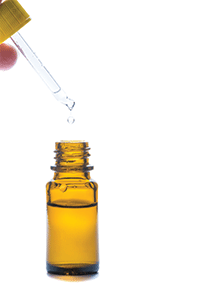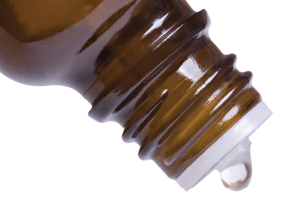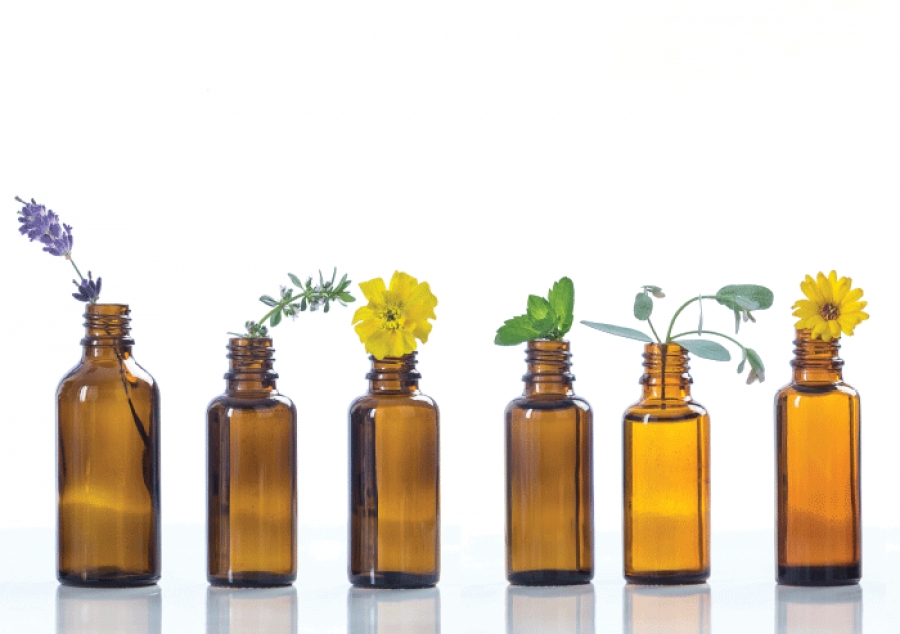 Gattefosse's Experiments with Essential Oils
Gattefosse's Experiments with Essential Oils
Gattefosse then started experimenting with the use of essential oils to treat wounded soldiers during World War I. He experimented with lavender, thyme, lemon, and clove for their antiseptic properties. He discovered that the oils were safer to use than other antiseptic agents being used at that time. This discovery reduced further infection and helped hospitals to better care for the soldiers. The aroma of the essential oils being used were therapy to the soldiers. This additional benefit with the essential oil aided in their recovery process. Gattefosse also discovered that the essential oils also induced a psychological effect and that certain combinations of oils delivered powerful results.
Elated about his discovery, Gattefosse wrote: "Besides their antiseptic and bactericidal properties widely used today...essential oils possess anti-toxic and antiviral properties, have a powerful vitalizing action, and undeniable healing power and extensive therapeutic properties."1
In 1937, Gattefosse wrote Aromatherapie; Les Huiles Essentielles Hormones Vegetales. It was later translated into English and renamed Gattefosse's Aromatherapy. He crafted the term aromtherapy for the use of essential oils on the body; as a result, he was dubbed the father of aromatherapy.
Essential Oils and Ancient Civilization
Although the term aromatherapy was not coined until 1937, essential oils had been used by the ancient Egyptian, Chinese, Japanese, and Indian civilizations. For centuries, these cultures used herbal-infused oils and developed medicinal treatments involving the use of essential oils to treat specific ailments. Even the Egyptians' mummification process required the use of plant and animal oils.
According to "Study Unwraps Ancient "Recipe" for Mummies," a National Geographic News article, "the linen wrappings were treated with resins from fir and pine trees, beeswax, myrrh, palm wine, cassia, camphor oil, and other substances that had drying or anti-bacterial properties."2 The Ancient Egyptians knew that the key to prolonging decay was with the use of antibacterial properties that were found in the extracts of nature. To this day, scientists are dumbfounded in regards to the brilliant use of herbs and oils these ancient civilizations used for healing benefits.
Gattefosse's experiments with essential oils forged an era of reacquainting ancient therapies with other scientists and chemists. Scholars became interested in finding alternative therapies to treat ailments other than by the Western methods that were being practiced. Utilizing nature's elements to deliver organic remedies became increasingly popular and, to this day, is booming in alternative therapies for skin and health ailments.
 Methods of Obtaining Essential Oils
Methods of Obtaining Essential Oils
Gattefosse's vat of lavender essential oil was created by one of two methods: distillation or expression.
"Distillation has been known for 5,000 years," states the National Association for Holistic Aromatherapy. "During the fifth century AD, the famed writer, Zosimus of Panopolis, refers to the distilling of a divine water and panacea." The National Association of Holistic Aromatherapy also states, "Throughout the early Middle Ages and beyond, a crude form of distillation was known and was used primarily to prepare floral waters or distilled aromatic waters...used in perfumery, as digestive tonics, in cooking and for trading."3 The distillation method requires the extraction of part of a plant that is achieved by sweating the natural oils out of the plant and collecting what is released during the process. There are various kinds of distillation, but they all collect what is released from the plant through the use of heat and water.
Expression, also known as cold pressing, differs from distillation in that it squeezes out the natural oils from the object that is being expressed. While the distillation method is used for flowers, roots, and other plant material, expression is used with rinds of fruit, particularly citrus. The rind of the citrus fruit is soaked in water and then expressed with a sponge. The sponge collects the oil from the rind and then the oil is squeezed into a container. Unlike the distillation process, this method does not require heat; the natural oils are literally being pressed out of the rind.
Use in the Treatment Room
The definition of an essential oil, as defined by the Merriam-Webster dictionary, is "an oil that comes from a plant, that smells like the plant it comes from, and that is used in perfumes and flavorings."4 The basic makeup of the plant is delivered with every drop of an essential oil, which is why essential oils are extremely potent and need a carrier oil – like coconut, vitamin E, olive, apricot, and safflower oils. Using an essential oil directly on the skin can irritate it and may even cause allergic reactions. It is extremely important that essential oils are handled with caution.
Bodyworkers have combined certain essential oils into their practice to assist in body and mind connection for their clients. The scent of the essential oils during a massage will enhance the client's experience and provide benefits for the body during the treatment. There are two different applications of essential oils a bodyworker could utilize when massaging their client; they can either use a massage oil with essential oils or apply drops of essential oils along the client's spine.
Blending an essential oil with a carrier massage oil is the most common form of aromatherapy used during massage. The scent of the essential oil filtering throughout the room, along with being massaged onto the skin, creates a nice aroma and induces relaxation. The second form of application is very direct with intent by the bodyworker and extremely therapeutic. It also triggers the limbic system, the part of the brain that correlates to emotions and motivations. By systematically dropping certain essential oils along the spine of dry skin and delicately stroking the oils across the back of the spine to create a goose bump response, the essential oils drain into the pores of the skin where the nerves of the parasympathetic nervous system will awaken the limbic system. Now that the limbic system has been awakened, the brain starts to feel certain emotions, as different essential oils are applied, different emotions will subconsciously emit within the brain and the body will be more in tune to the bodywork that is being performed. The latter method of application requires a special technique and should be done by a bodyworker who has been trained with the knowledge of contraindications of different oils and the benefits of each oil.
Bodyworkers deliver essential oils onto the skin through massage for an aromatherapy experience, but when it comes to skin care, although the aroma of the product is a bonus, the effect on the skin is the most important factor. For many years, florals and botanicals have reigned as a luxurious way to deliver a scented product, but, recently, consumers are shying away from heavy fragrances. Products no longer need to smell like rose, jasmine, or musk for consumers to make a purchase. Many consumers want products that are natural, organic, and the most effective for their skin.
 A client that suffers from acne would find great benefit in using products that contain lavender, neroli, cedarwood, tea tree, and other antibacterial essential oils. Clients that are concerned about aging skin should look for products that contain citric or rose hip essential oils. Essential oils are becoming commonplace for natural and organic products because they are natural preservatives that enables longevity for a product's shelf life.
A client that suffers from acne would find great benefit in using products that contain lavender, neroli, cedarwood, tea tree, and other antibacterial essential oils. Clients that are concerned about aging skin should look for products that contain citric or rose hip essential oils. Essential oils are becoming commonplace for natural and organic products because they are natural preservatives that enables longevity for a product's shelf life.
Aromatherapy can open the body to healing, but it can also shut it down if the aroma does not agree with the senses. Therefore, it is important to find essential oils that provide the most benefit for each client. These concentrated healing oils work wonders in the treatment room and, when used correctly, can aid in the healing of numerous ailments.
References
1 Gattefossé, R. M. (1993). Gattefossé's aromatherapy.
2 Mayell, H. (2001, October 30). Study Unwraps Ancient "Recipe" for Mummies. National Geographic News.
3 National Association for Holistic Aromatherapy. naha.org
4 Merriam-Webster Dictionary. (n.d.). Essential Oil.
 Amra Lear is a licensed massage therapist and aesthetician. She has been working in the spa industry for 16 years, working for two of the most prestigious spas in the world. Her clientele consists of the stars, moguls, and people alike. She has been trained by Japanese shiatsu masters and the founders who pioneered such wonderful modalities such as ashiatsu, mother massage, and lulur. Skin is her ultimate passionate. She has dedicated the last six years to research and education of biochemistry to better understand the biochemical response to products used on
Amra Lear is a licensed massage therapist and aesthetician. She has been working in the spa industry for 16 years, working for two of the most prestigious spas in the world. Her clientele consists of the stars, moguls, and people alike. She has been trained by Japanese shiatsu masters and the founders who pioneered such wonderful modalities such as ashiatsu, mother massage, and lulur. Skin is her ultimate passionate. She has dedicated the last six years to research and education of biochemistry to better understand the biochemical response to products used on
the skin.
